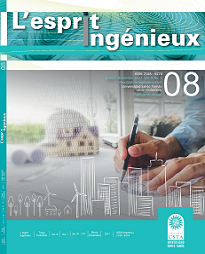E.I.A. “Santo Domingo” Building, “Santo Tomas” University, Tunja
Main Article Content
Abstract
Santo Tomás University in Tunja, has as one of its main objectives, the training of high quality professionals. For this reason, it has carried out the creation of new educational spaces, contemplated through the construction of a building called the Santo Domingo Building, which until now is under construction. The analysis of environmental damage was developed through different methodologies taking into account that today buildings are causing significant impacts on the planet, impacts that can be determined and qualified according to time through various evaluative processes in order to achieve environmental and economic sustainability for new buildings. Through this article we will present several ways that were carried out to determine the environmental impact that the Santo Domingo building would cause in three stages as they are; the adequacy of the land, construction and maintenance, in such a way that this assessment was carried out through matrices that allowed us to calculate the magnitude and importance generated by a construction in the environment in order to propose the mitigation processes, generating possible solutions to the most relevant impacts.
Article Details
How to Cite
Coca Moreno, D., Mariño Valcárcel, G., & Medina Díaz, C. (2017). E.I.A. “Santo Domingo” Building, “Santo Tomas” University, Tunja. L’esprit Ingénieux, 8(1). Retrieved from http://revistas.ustatunja.edu.co/index.php/lingenieux/article/view/1657
Section
Artículos L´esprit Ingenieux Vol.8-1
References
Calderón, T., & Javier, J. (2009). Análisis constructivo del proceso de evaluación de impacto ambiental en Colombia. Propuestas de mejora.
Ponce, V. (2011). La Matriz de Leopold para la evaluación del impacto ambiental. Recuperado de http://ponce. sdsu. edu/la_matriz_de_leopold. html.
Espinoza, G. A. (2002). Gestión y fundamentos de evaluación de impacto ambiental. BID/CED.
Pereira, I. (2011). La matriz de Leopold en EIA. Disponible en dirección electronica http://www. eoi. es/blogs/ivanpereira/
la-matriz-de-leopold-en-eia/, visitado en Abril, 10.
Neumann, A. L., Millán, M. I., & Aumente, P. A. R. (2005). Investigación e impacto ambiental de los edificios. La Energía. Informes de la Construcción, 57(498), 47-61.
Rivas, H. (1998). Los impactos ambientales en áreas turísticas rurales y propuestas para la sustentabilidad. Gestión turística, (3), 4.
http://www.ustatunja.edu.co/galerias -edificio-santo-domingo
Introducción Metodologías (Javier Eduardo Becerra)
Metodología general para la presentación de estudios ambientales (Ministerio de Ambiente, Vivienda y Desarrollo Territorial
http://www.ideam.gov.co/documents/ 21021/21789/1Sitios+turisticos2.pdf/ cd4106e9-d608-4c29-91cc-16bee91 51ddd
http://www.boyaca.gov.co/prensa-publicaciones/mi-boyac%C3%A1/hidrogra fia-boyacense
Ponce, V. (2011). La Matriz de Leopold para la evaluación del impacto ambiental. Recuperado de http://ponce. sdsu. edu/la_matriz_de_leopold. html.
Espinoza, G. A. (2002). Gestión y fundamentos de evaluación de impacto ambiental. BID/CED.
Pereira, I. (2011). La matriz de Leopold en EIA. Disponible en dirección electronica http://www. eoi. es/blogs/ivanpereira/
la-matriz-de-leopold-en-eia/, visitado en Abril, 10.
Neumann, A. L., Millán, M. I., & Aumente, P. A. R. (2005). Investigación e impacto ambiental de los edificios. La Energía. Informes de la Construcción, 57(498), 47-61.
Rivas, H. (1998). Los impactos ambientales en áreas turísticas rurales y propuestas para la sustentabilidad. Gestión turística, (3), 4.
http://www.ustatunja.edu.co/galerias -edificio-santo-domingo
Introducción Metodologías (Javier Eduardo Becerra)
Metodología general para la presentación de estudios ambientales (Ministerio de Ambiente, Vivienda y Desarrollo Territorial
http://www.ideam.gov.co/documents/ 21021/21789/1Sitios+turisticos2.pdf/ cd4106e9-d608-4c29-91cc-16bee91 51ddd
http://www.boyaca.gov.co/prensa-publicaciones/mi-boyac%C3%A1/hidrogra fia-boyacense

